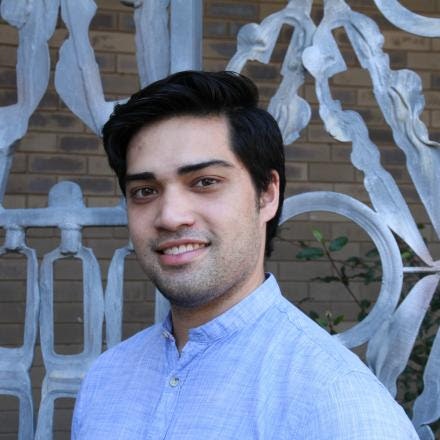O ai a’u? (Who am I?): love and art at Manamea Art Studio
Mitiana Arbon
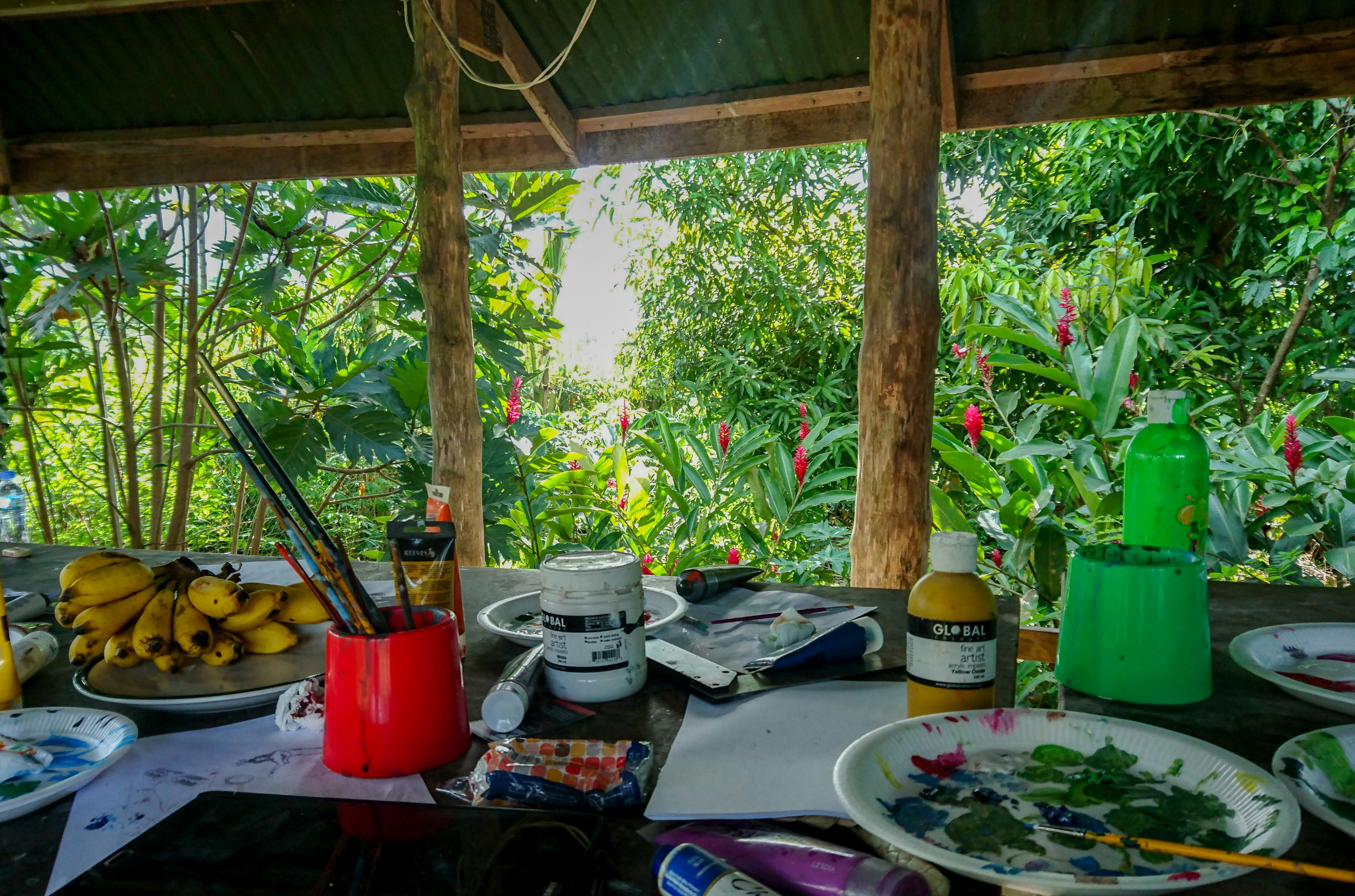
Workspace of Manamea Art Studio in Vaitele Fou, Upulo, Samoa, November 2017; photo: Mitiana Arbon, courtesy the artist.
Like a tree, a culture is forever growing new branches, foliage, and roots. Our cultures, contrary to the simplistic interpretation of our romantics, were changing even in pre-papalagi times through inter island contact and the endeavours of exceptional individuals and groups… No culture is ever static and can be preserved… like a stuffed gorilla in a museum. […] Our quest should not be for a revival of our past cultures but for the creation of new cultures which are based firmly on our own pasts.
Albert Wendt, A New Oceania, 1982 (1)
Whenever I begin writing I like to stop and meditate on the words of the Samoan author Albert Wendt whose vision has stimulated many an artist, writer and poet since he wrote A New Oceania in 1982. This critical essay, that focused on the potential of artists and creative practitioners engaging and interrogating perceptions of cultural fixity, remains salient for the present generation of artists, scholars and creative practitioners in the region. Advancing such a vision invites a reflection on the possibilities available for artists to maintain their practices as well as maintaining financial viability. In the context of Wendt’s archipelagic home of Samoa, the practical realities of establishing and developing art within established frames of references are limited.
In the Samoan capital Apia, there are no modernist white cubes for exhibiting art, nor permanent national edifices for art collections. The potential for exhibitions in the Western sense are distributed among small and privately owned establishments, such as the Madd Gallery, Tiapapata Art Centre and the Vanya Taule’alo Gallery. Larger exhibitions are sporadically displayed in venues such as government buildings, hotels and church facilities, as well as the National University of Samoa. Of course, the relatively young Samoan Arts Council (established in 2014) helps to facilitate such events, however much of the art scene depends upon grassroots endeavours to nurture art and its making in the shadow of negligible public funding. In this challenging environment, Manamea Art Studio, an artists’ collective established in 2013, has had to construct its own model to complement Samoa’s cultural and economic landscape, experimenting with their own practices and navigating the waters of cultural expectations.
When I caught up with Manamea Art Studio—headed by Nikki Mariner-Peseta and her husband Lalovai Peseta—they were gathered under the shade of the breadfruit tree in their Vaitele Fou residence, with their adopted rescue dog, Frida Kahlo, yapping in the yard. Their setup was intimate and reflective of many homes across Upolu, from the ubiquitous thatched fale (a local open pillared house) they used for carving and displaying their works among the red Teuila flowers in the garden, to a colourful green fale palagi (Western style house), quadrupling as their painting space, tattoo parlour, kitchen and home for Nikki, Lalovai and his sons Leonardo, Michelangelo and Raphael.
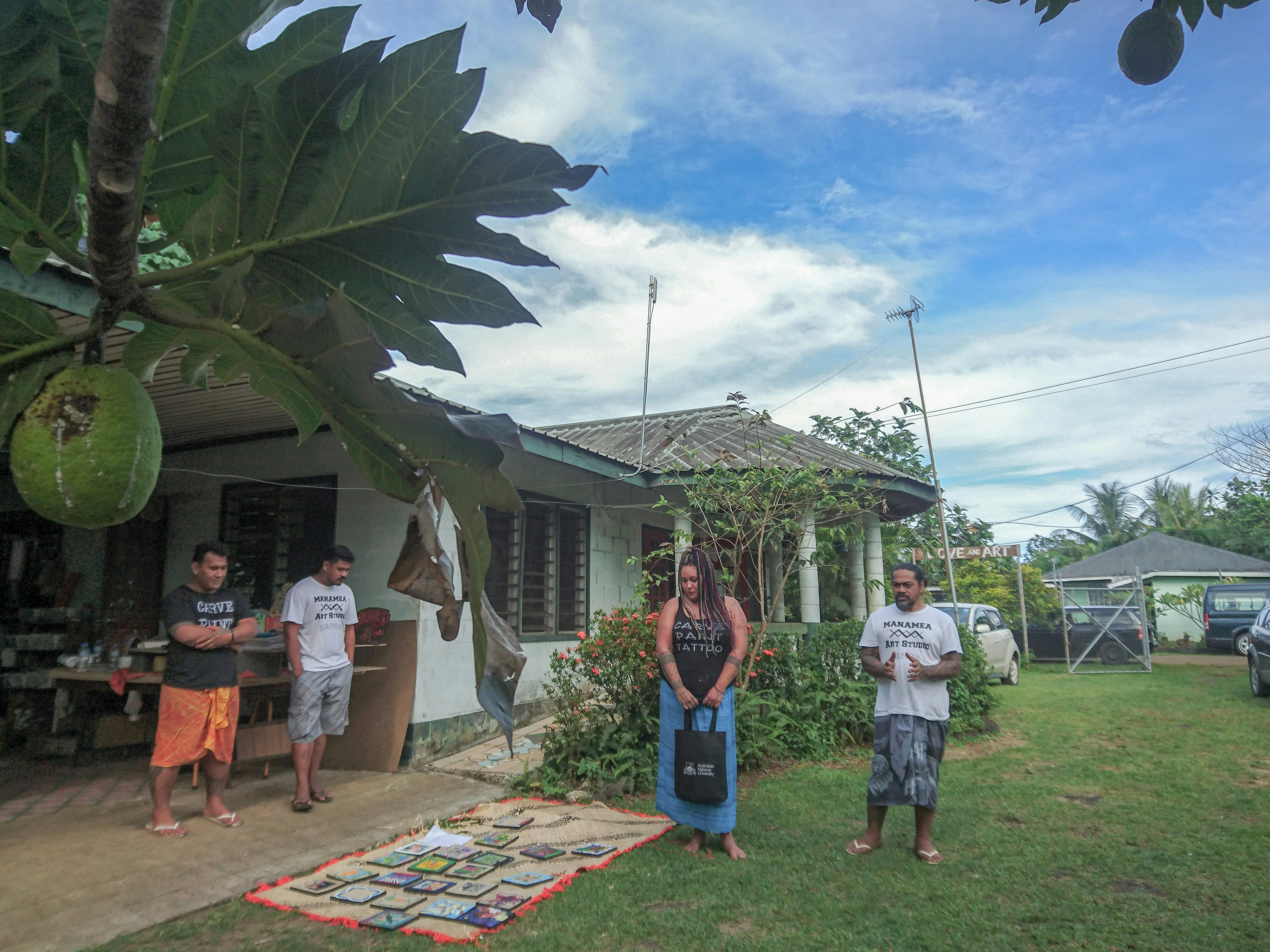
Pele, William, Nikki and Lalovai gathered outside for a workshop in Vaitele Fou, Upolu, Samoa, December 2017; photo: Mitiana Arbon
Naming the studio Manamea is significant: a term often used to refer to a lover, or for someone you treasure, it reflects the intimate love that is self-evident between the artists and their affection for the arts. The couple’s relationship flourished through a love of art, having first met each other in the Solomon Islands at the 2012 Festival of the Pacific Arts. Lalovai was an artist and former teacher representing American Samoa at the time, while Nikki was a Pacific Studies doctoral candidate leading a field school of scholars from the Australian National University. Together, they dreamt of a way to create, live and work as a couple. Less than a year later, in the back fale of Lalovai’s parent’s house on Savai’i, Manamea Art Studio was born.
Commercially successful from the very beginning, Manamea Art Studio soon found that Savai’i’s relatively small population meant that the Studio’s expansion into an international market required frequent export shipments and their associated and considerable costs. This necessitated a move to the more accessible and connected island of Upolu. Here the Studio continued to maintain a steady stream of clients in carving, tattooing and painting, with a large portion of the business driven through its sustained use of social media. Across a variety of platforms, Manamea Art Studio describes itself as 100% home grown and independent, and not sponsored by nor affiliated with any organisation. This choice to remain local allows for the Studio to provide direct economic injection into the local creative industry, and counter the trend of outward migration that has seen many Samoans and creative individuals move overseas or spread their time transnationally in New Zealand and Australia.
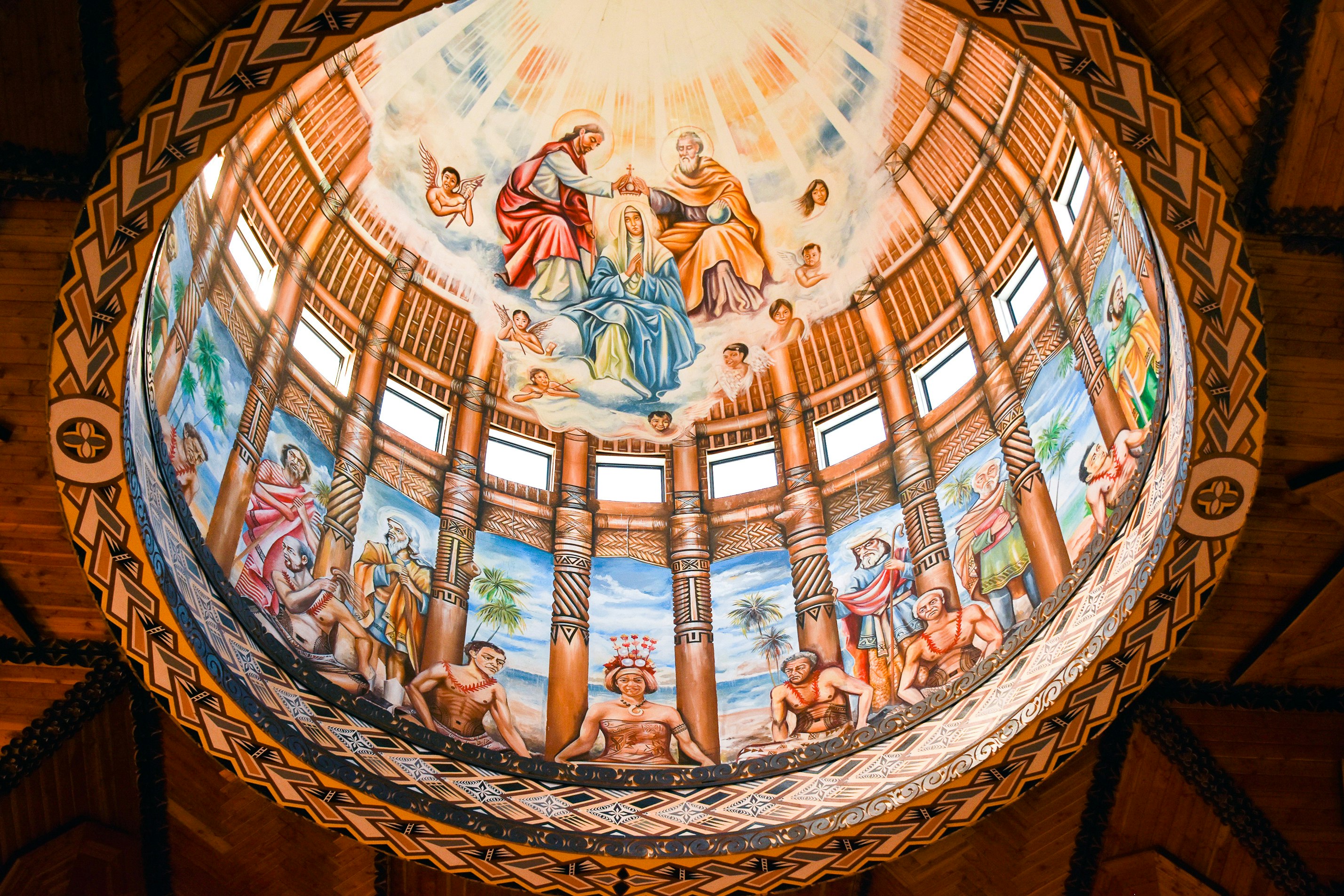
Details of the cupola of the Immaculate Conception Cathedral, Mulivai, Apia, Samoa, November 2017; photo: Mashaal Khan, courtesy the artist.
Naming the studio Manamea is significant: a term often used to refer to a lover, or for someone you treasure, it reflects the intimate love that is self-evident between the artists and their affection for the arts.
The art of Manamea Art Studio is arguably produced in a Samoan syncretic style. It draws inspiration from established forms, while blending elements of carving, tatau (tattooing), siapo (tapa cloth) and elei (cloth printing derived from tapa designs) synonymous with older Samoan aesthetic forms, remixing these with Western forms of abstraction, figurative painting and more recent carving techniques. Notable examples of this style can be found across Samoa, from the traditional ‘ava (kava) ceremony attended by Samoan angels and the twelve apostles in the cupola of the Immaculate Conception Cathedral in Mulivai, to gender specific tatau patterns used in local sportswear label.
This style is an important counter to the persistent aesthetic binaries of ‘arts vs crafts’, often applied to Samoan art forms, that sees the elevation of male gendered practices such as carving over that of textiles such as siapo in institutional contexts. Manamea places a concerted emphasis on the treatment of surfaces from skin to wood to canvas as equal and interchangeable platforms of artistic expression. This artistic approach even includes the literal use of Lalovai’s body as a canvas, exhibiting a tattoo transfer of his portrait of Nikki, titled Blue No More (2012). Likewise, much of their carving features the banded patterns drawn from the Samoan tatau, and applied referentially to the gender-specific nature of motifs whether they’re found within a pe’a (men’s tattoo) or a malu (female tattoo).
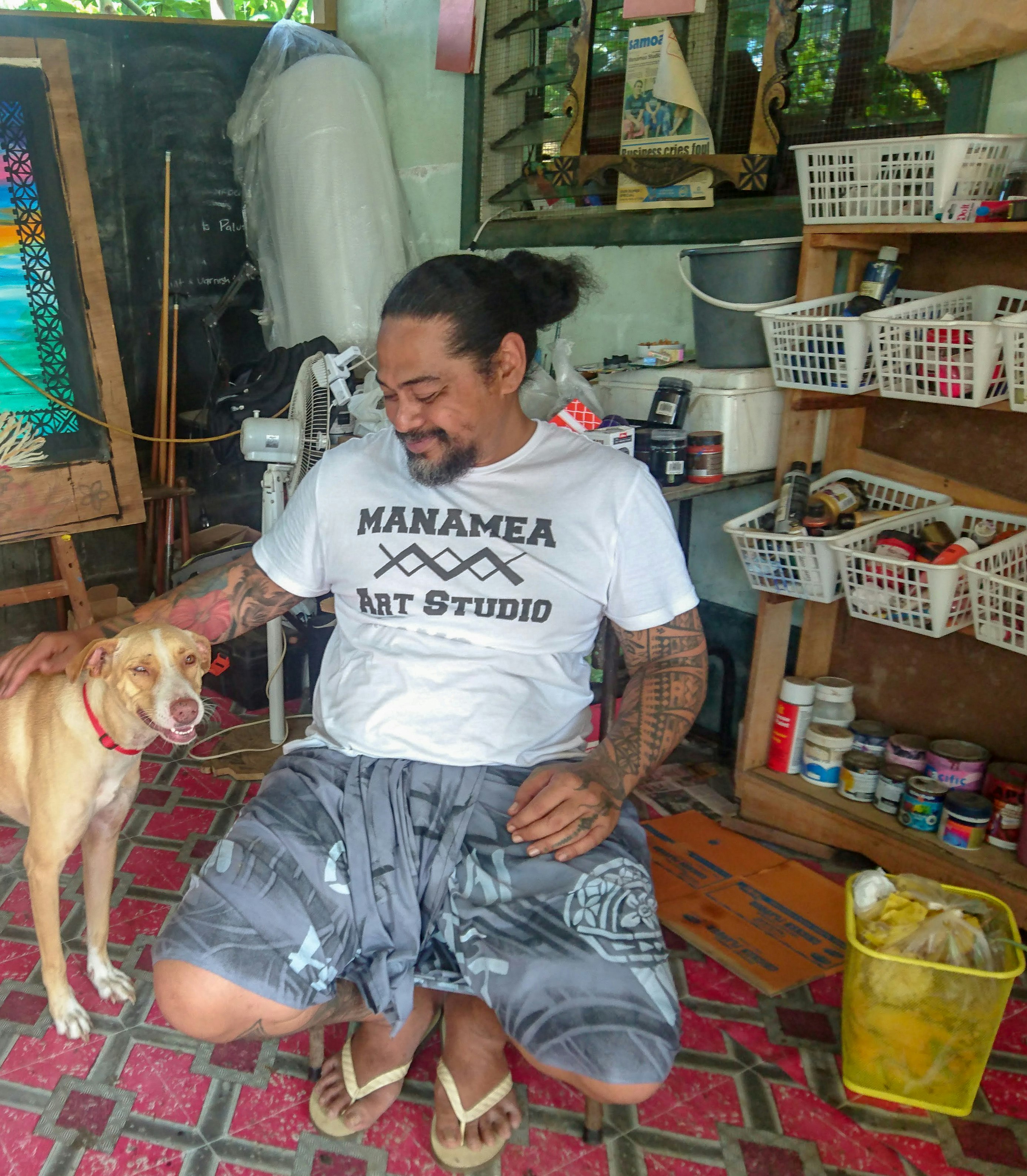
Lalovai Peseta and Nikki Mariner Peseta at Manamea Art Studio, November 2017; photo: Mashaal Khan, courtesy the artist.
Thematically, the work of Manamea Art Studio shows an ongoing concern and conversation with deeper social enquiries of contemporary relationships with the fa’asamoa, Samoan culture and way of being. The creation of art as a viable and sustainable business is often challenged by the social obligations of fa’alavelave (gift exchanges) expected of Lalovai as a matai (titled chief). These concerns are evoked within painting, such as Lalovai’s purple monochrome self-portrait IFOGA – FORGIVENESS (2017) that examines his own sense of familial obligations through its depiction of the artist deferentially dressed as a tulafale (chiefly orator) surrounded by his children. Nikki’s practice is equally introspective, providing cheeky reflections and critiques of the societal expectations placed on women in Samoa. Her most recent series of acrylic paintings explores the boundaries of decorum expected of a tausi (wife of a matai), contrasted with the more free-spirited beliefs and upbringing depicted in her painting Tausi In The Streets But A Freak In The Sheets (2016).
Cultural obligations experienced by Lalovai and Nikki also form a significant portion of creative output for the business with a large percentage of their income sourced from carving commissions for familial and social occasions. These works are predominantly focused on sculptural centrepieces for the cycle of weddings, funerals and celebratory events—even a trophy for the historic test match between the New Zealand All Blacks and Manu Samoa in 2015. Each carving is uniquely tailored and visually responsive to the client’s personal history. This bespoke attention extends to the choice of motifs and visuals for clients’ tatau.
Working from Samoa requires the Manamea Art Studio to maintain a constant online profile through Facebook and Instagram as the majority of their clientele comprises diasporic Samoan communities within Australia, the United States and Europe. Through social media the Studio can feed profits locally, helping to reinforce community networks while collapsing local-global divides in its output. The Studio’s relative success has allowed it to employ and nurture other emerging young local artists such as Pele Loi, a former student of Lalovai and William Mauola, a graduate of Leulumoega Fou School of Fine Arts, Samoa’s only dedicated school of arts, and Lalovai’s alma mater. While local buyers make up only ten per cent of their customer base, Nikki explains that this is inhibited by the affordability of art commissions and has led the Studio to develop a separate pricing structure that allows local Samoans to buy and commission pieces.
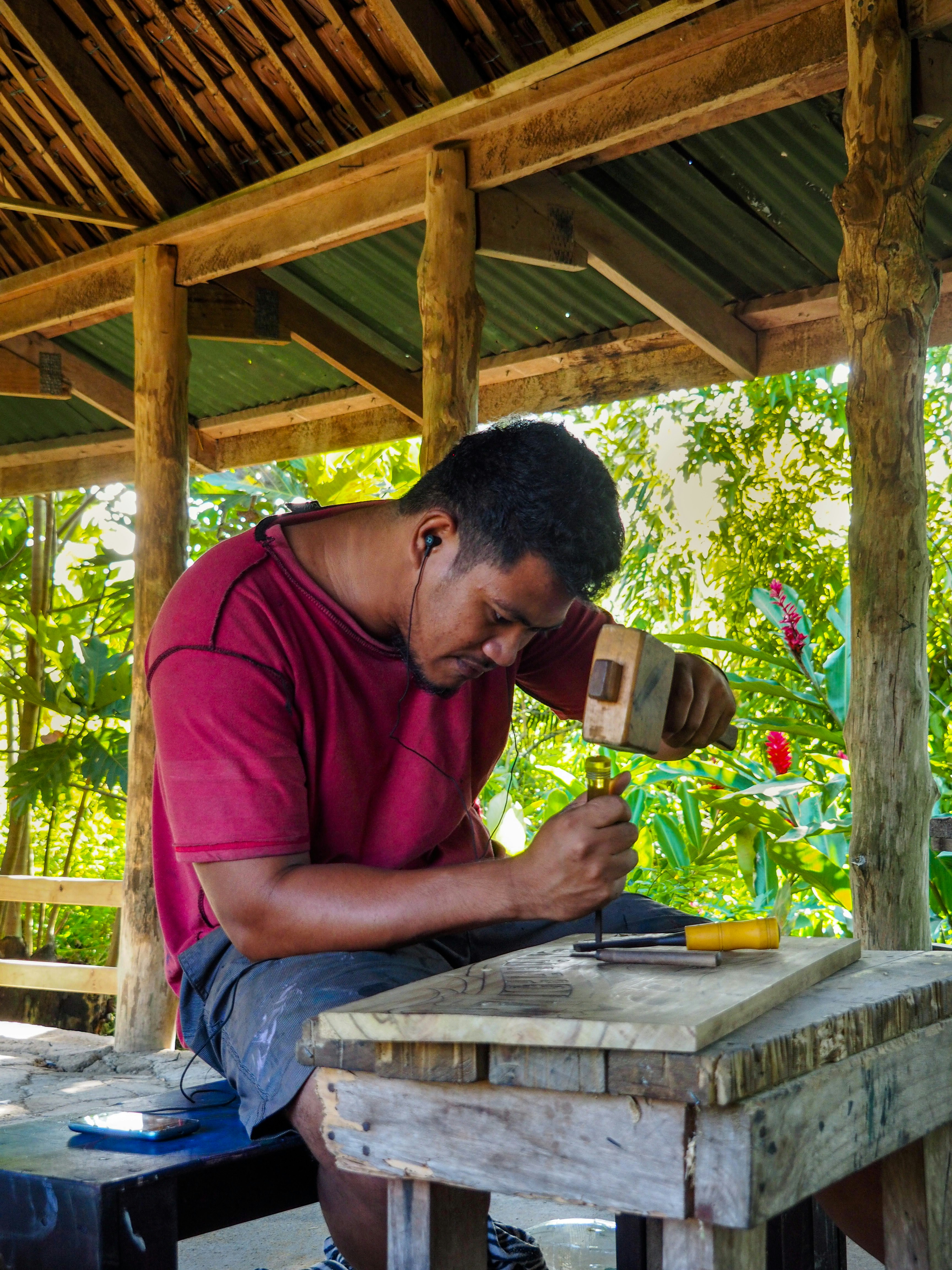
Manamea Art Studio carver William Mauola at work, November 2017; photo: Oliver Lilford, courtesy the artist.
Running the Studio on Upolu is still not without its difficulties. Nikki and Lalovai talk about the unpredictability of power outages and the Herculean task of sourcing basic art equipment, from paintbrushes to canvases. In 2017, the couple decided to surmount these challenges launching their own exhibition in their backyard fale, Who am I? O ai a’u? This represented their first attempt to display their artistic work as a collective, while also providing a raw reflection of local curatorial reality. The displaying of artworks was achieved through placement of large boards between the fale pillars which were used to mount their paintings. As part of the exhibit, they produced lectures for students of the Leulumoega Fou School of Fine Arts, sharing practical experiences on creating an arts-based business. These practical lessons are important in fostering the continuing success of the next generation of artists as they offer an alternate narrative of how to continue to practice, as well as support one’s family living in a country without government funding for the arts.
Manamea Art Studio is an imaginative and resourceful success story that produces a raw and rooted sense of local expression. Within the short space of a few years, the Studio has grown beyond a dream, encompassing a steadily growing community of artists and practices. Since my visit in November 2017, the Studio has since moved to an expanded premise in Vaigaga, situated along the meandering and populous coastal road that stretches between Faleolo International Airport and downtown Apia. Now enhanced with a formal dedicated art space and studio as well as more artists added to the team, Manamea is readying for the upcoming exhibition due to open in May 2018, The New Samoa. In conversation, Nikki notes the desire to continue to further expand their capacity and to feed more into the island’s art scene, including the development of art classes, workshops, and a larger space to host exhibitions and guest artists. For now, the future is bright as the studio continues to define, produce, and create their own model of Samoan art, navigating past dichotomies of the traditional and the modern, so that it might provide a creative voice for contemporary Samoa.
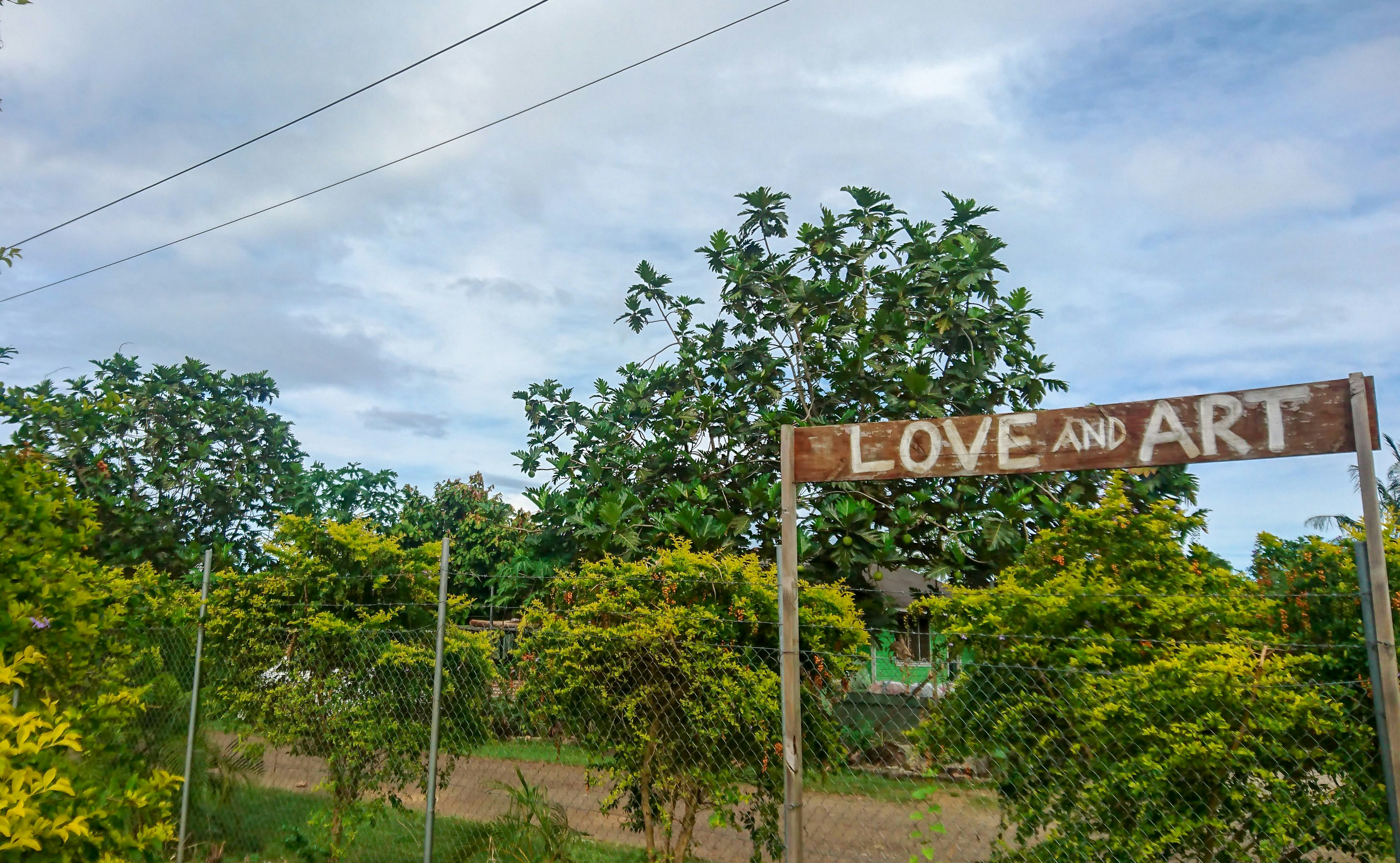
Manamea Art Studio sign visible from inside the compound in Vaitele Fou, Upolu, Samoa, November 2017; photo: Mitiana Arbon, courtesy the artist.
Notes
(1) Wendt, Albert, ‘Towards a new Oceania’ in Writers in East-West Encounter: New Cultural Bearings, edited by Guy Amirthanayagam (London: Palgrave Macmillan, 1982) 202–215.
This essay takes its title from the exhibition Who Am I? O Ai A’u presented at Manamea Art Studio 24–30 June 2017.
About the contributor
Mitiana Arbon is a Sāmoan–Australian Pacific Studies doctoral candidate at the Australian National University, Canberra.
